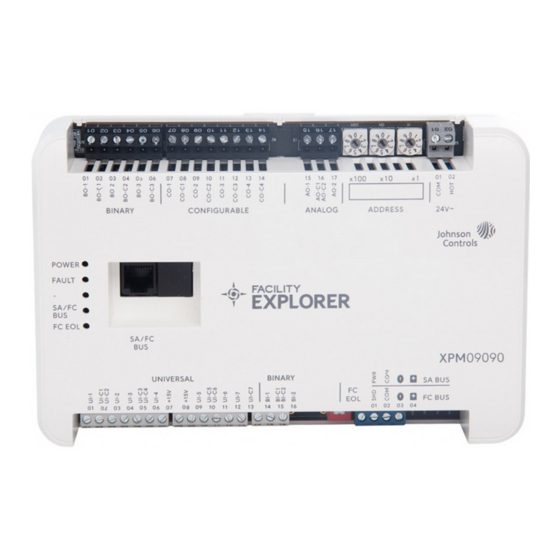
Table of Contents
Advertisement
Application
The F4-XPM series expansion I/O modules can serve
in one of two capacities depending on where they are
installed in the system. When installed on the Sensor/
Actuator (SA) Bus of an equipment controller, an XPM
expands the input and output interfaces that can be
used with that equipment controller. When installed on
the Field Controller (FC) Bus of a FX-SNC, an XPM can be
used as I/O point multiplexors to support monitoring and
control from a FX-SNC. The point multiplexor can also
be useful for sharing points between other equipment
controllers on the FC Bus using peer-to-peer connectivity.
XPMs operate on an RS-485 BACnet MS/TP Bus and are
BACnet Testing Laboratory (BTL) listed and certified to the
BACnet Smart Actuator (B-SA) profile.
Communications Protocols
The XPM expansion modules can communicate using
BACnet MS/TP, or wireless Zigbee
Wireless Field Bus Router (on the FC Bus only). By default,
the XPM expansion modules communicate using the
BACnet MS/TP protocol. The BACnet protocol is a standard
for ANSI, ASHRAE, and the International Standards
Organization (ISO) for building controls. To configure
these expansion modules in a wireless application
installation, see
Configuring wireless
Note: Using Controller Configuration Tool (CCT)
10.1 and later, FX equipment Controllers can be
configured to communicate using either the BACnet
MS/TP or the N2 field bus networking protocol.
The operation of an XPM on the SA Bus of an
equipment controller is not affected by the selection
of the BACnet MS/TP or the N2 protocol in the host
controller.
North American Emissions Compliance
United States
This equipment has been tested and found to comply
with the limits for a Class A digital device pursuant to
Part 15 of the FCC Rules. These limits are designed
to provide reasonable protection against harmful
interference when this equipment is operated in a
commercial environment. This equipment generates,
uses, and can radiate radio frequency energy and, if not
installed and used in accordance with the instruction
manual, may cause harmful interference to radio
communications. Operation of this equipment in a
residential area may cause harmful interference, in which
case the users will be required to correct the interference
at their own expense.
F4-XPM Expansion Modules Installation Guide
using a ZFR/ZFR Pro
®
communications.
Canada
This Class (A) digital apparatus meets all the
requirements of the Canadian Interference-Causing
Equipment Regulations.
Cet appareil numérique de la Classe (A) respecte toutes
les exigences du Règlement sur le matériel brouilleur du
Canada.
Installation
Observe the following guidelines when installing an XPM
expansion module:
• To minimize vibration and shock damage transport the
expansion module in the original container.
• Verify that all parts shipped with the expansion module.
• Do not drop the expansion module or subject it to
physical shock.
Parts included
• One XPM expansion module with removable terminal
blocks (Input/Output, Power and SA bus terminal
blocks)
• One installation guide sheet
Materials and special tools needed
• Three fasteners appropriate for the mounting surface
(M4 screws or #8 screws)
• One 20 cm (8 in.) or longer piece of 35 mm DIN rail and
appropriate hardware for DIN rail mount (only)
• Small straight-blade (1/8 in. or 3.2 mm) or Philips #2
screwdriver for securing wires in the terminal blocks
Physical features
The following figures display the physical features of XPM
expansion modules, and the accompanying table provides
a description of the physical features and a reference to
further information where required.
*241014302155-*
F4-XPM04060, F4-XPM09090, F4-XPM18000
Part No. 24-10143-02155 Rev -
2020-11-11
(Barcode for factory use only)
Advertisement
Table of Contents

Summarization of Contents
North American Emissions Compliance
United States Compliance
Details FCC compliance for Class A digital devices in commercial settings.
Canadian Emissions Compliance
States compliance with Canadian Interference-Causing Equipment Regulations.
Installation
Included Parts and Tools
Lists components and tools required for module installation.
Physical Features Overview
Introduces the physical characteristics and layout of XPM modules.
Mounting Guidelines
Provides guidelines for securely mounting the expansion module.
DIN Rail Mounting
Steps for mounting the expansion module on a 35 mm DIN rail.
Wall Mounting
Steps for mounting the expansion module directly on a wall.
Wiring Guidelines
Critical Safety Warnings
Essential safety precautions for electric shock and property damage.
Terminal and Wiring Specifications
Overview of terminal functions, ratings, and wiring requirements.
Input/Output Wiring Details
Specific guidance for wiring module inputs and outputs.
Cable Length and Load Current
Guidance on cable length based on wire size and load current.
Bus and Power Wiring
Guidelines for wiring communication buses and the power supply.
Setup and Adjustments
Wireless Communications Setup
Steps to configure the expansion module for wireless communication.
Device Addressing
Setting a unique device address for bus communication.
Module Cover and Terminal Block Removal
Procedures for removing the module cover and terminal blocks.
EOL Switch and Jumper Configuration
Setting the EOL switch and UI current loop jumpers.
Operation and Troubleshooting
Setting up local display, commissioning, and troubleshooting using LEDs.
LED Status Indicators
Explains LED states for troubleshooting expansion modules.
Technical Specifications
Product Compliance
Lists regulatory compliance standards applicable to the product.
Repair and Warranty Information
Details on product repair, warranty, software terms, and patents.
Contact and Support Information
Provides contact details for technical support and regional offices.
















Need help?
Do you have a question about the XPM09090 and is the answer not in the manual?
Questions and answers